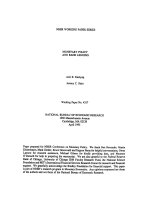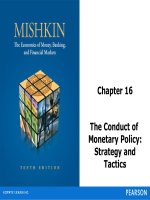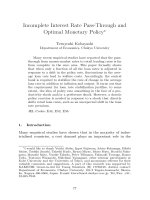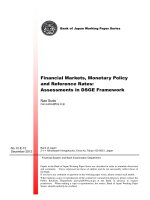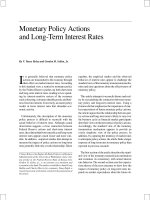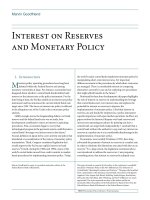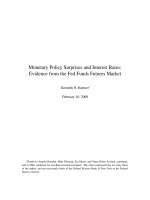Explaining nEw ZEaland’s MonEtary policy pot
Bạn đang xem bản rút gọn của tài liệu. Xem và tải ngay bản đầy đủ của tài liệu tại đây (3.98 MB, 24 trang )
Explaining nEw ZEaland’s MonEtary policy 1
MonEtary policy
Explaining nEw ZEaland’s
What is monetary policy? 3
Developments in monetary policy
What is inflation? 5
How inflation is measured
Why inflation is damaging
When inflation gets rampant
The Reserve Bank inflation calculator
Deflation
Monetary policy implementation in New Zealand 9
The Policy Targets Agreement
The Official Cash Rate
OCR accountability
The monetary policy process in New Zealand 12
The OCR’s impact on interest rates
The impact on the exchange rate
The impact on economic activity
Gross Domestic Product
The impact on inflation
Supply and demand
Inflation expectations
Monetary policy complications
Economic projections
contEnts
2 Explaining nEw ZEaland’s MonEtary policy
How monetary policy works over the business cycle 19
Why do business cycles occur?
Other roles for monetary policy 22
Monetary policy and growth
Monetary policy and employment
Monetary policy and the current account
Glossary 24
ISBN 0-978-9582675-3-3 (print)
ISBN 0-978-9582675-4-0 (online)
Copyright © 2007 Reserve Bank of New Zealand
First printed July 2007
Reprinted September 2009
Explaining nEw ZEaland’s MonEtary policy 3
Today, the Reserve Bank uses monetary
policy to control inflation and keep it
within a specific target band. Monetary
policy is encountered by ordinary
New Zealanders in several ways. New
Zealanders directly encounter the main
instrument of monetary policy, the Official
Cash Rate (OCR), when they borrow
money at retail interest rates through
mortgages, credit cards or personal
loans, or when they save money in bank
accounts that earn interest. Retail rates of
interest are directly related to the OCR set
by the Reserve Bank.
Other ways that New Zealanders
encounter monetary policy are through its
effect on inflation and economic activity.
Since the late 1980s, monetary policy has
contained inflation within narrow limits
– so effectively, in fact, that we forget
that just a generation ago it was thought
normal to have annual price rises of 16 or
more percent. Monetary policy also helps
prevent large swings in economic growth
and employment.
what is
MonEtary policy?
Monetary policy is the term used
by economists to describe ways
of managing the supply of money
in an economy.
The Reserve Bank of New
Zealand has had the role of
managing monetary policy in
New Zealand since its foundation
in the mid-1930s.
4 Explaining nEw ZEaland’s MonEtary policy
dEvElopMEnts in
MonEtary policy
Monetary policy aims and methods have
changed over time. In the mid-20th
century, a period when government
regulations played a significant part in the
economy, the Reserve Bank was instructed
to use monetary policy to enhance
growth, reduce unemployment, and keep
prices stable.
At the time, this was a largely
administrative exercise. The exchange rate
was fixed between 1949 and 1967, and
there were no financial markets in the
modern sense. However, the effort was
not particularly successful, partly because
the policy tools the Reserve Bank had to
work with were not well suited for such a
wide range of tasks.
Inflation targeting was a response to
the experience of the 1960s and 1970s.
New Zealand, like most western nations,
suffered from high inflation from the late
1960s. Government efforts to reduce it
by regulation were not effective, but both
research and practical experience overseas
indicated that inflation could be reduced
by controlling the money supply.
Inflation control by the central bank
has historical precedent. As early as the
1690s, the Bank of England was charged
with maintaining the value of coinage,
albeit in an economy that differed
significantly from the modern one. In the
1930s, the Swedish Rijksbank set price
stabilisation as a goal of monetary policy.
This was price-level targeting rather than
inflation control, but it has been argued
that this helped the Swedish economy
weather the worldwide depression of the
day. At times in the past, the Reserve
Bank of New Zealand was also instructed
to keep prices under control, albeit as one
of a wider – and not always compatible
– range of monetary policy goals.
The worldwide trend to liberalise
during the early 1980s – and the
emergence of financial markets – made
new avenues of inflation control
possible. New Zealand’s own period of
liberalisation, in the mid-to-late1980s,
thus effectively opened the way for
inflation-control policies. A general drive
to control inflation was fairly standard in
western economies by this time, but in
1989/90 New Zealand pioneered a further
monetary policy step – a specific target
band.
Today, this style of inflation targeting
is shared with a number of significant
economies worldwide, including Canada,
the United Kingdom, Norway, Poland,
South Africa, Sweden, Australia and the
Eurozone.
Further details of New Zealand’s
economic history and the Reserve Bank’s
role are published in the brochure The
Reserve Bank and the Economy.
Explaining nEw ZEaland’s MonEtary policy 5
To understand monetary policy and the
way the OCR works, we need to first
understand inflation. This is the term
used to describe the average rise in prices
through the economy, and it means that
money is losing its value.
The underlying cause is usually that too
much money is available to purchase too
few goods and services, or that demand
in the economy is outpacing supply. In
general, this occurs when an economy
is so buoyant that there are widespread
shortages of labour and materials, and
people can charge higher prices for the
same goods or services.
Inflation can also be caused by a rise in
the prices of imported commodities, such
as oil. However, this sort of inflation is
usually more transient, and therefore less
crucial than the structural inflation caused
by an over-supply of money.
how inflation is MEasurEd
There are various ways of measuring
inflation. The one used in the Policy
Targets Agreement (PTA) is the All Groups
Consumers Price Index (CPI) published
by Statistics New Zealand. This records
the change in the price of a weighted
what is
inflation?
In 1989, the Reserve Bank was
formally given the task of using
monetary policy to control
inflation.
Since 1999, the Bank has
done so by setting the ‘Official
Cash Rate’ (OCR) – in other
words, by setting the wholesale
price of borrowed money.
Through the OCR, the
Reserve Bank is able to influence
the wholesale price of money
and, via the linkages that this
has to the banking system and
financial markets, influence a
range of economic factors that
help keep inflation under control.
6 Explaining nEw ZEaland’s MonEtary policy
‘basket’ of goods and services purchased
by an ‘average’ New Zealand household.
The percentage change of this index is
typically referred to as ‘CPI inflation’.
The contents of the basket are
defined by Statistics New Zealand, which
periodically reviews and re-weights them,
using data obtained from its annual
Household Economic Survey. This is
necessary because the basket of goods
and services purchased by the average
household changes over time.
graph 1
cpi inflation 1862-2007
w
hy inflation is daMaging
Inflation can be damaging to individuals,
firms and the economy as a whole.
Individuals may be left worse off if prices
rise faster than their incomes. This is likely
to have more impact on the poor, who are
on modest and fixed incomes, while the
more affluent may be more able to protect
themselves from inflation.
High inflation, which generally
coincides with variable inflation, also
makes it more difficult for individuals and
firms to efficiently plan their decisions
to invest, save and consume. This is
because high inflation reduces people’s
certainty around how much their money
will be worth in the future. Firms may
then become reluctant to invest in long-
term projects, such as research and
development, even though in the long
term those projects may be of great value.
This inevitably reduces the economy’s
long-term growth potential. Inflation
also discourages savings; if prices are
increasing, it is better to spend now.
Bouts of high inflation also tend to
go hand in hand with an overheated
economy and can accentuate boom-bust
cycles in the economy. Such volatility in
the economy can have destructive social
consequences, including large swings in
unemployment.
-6
-4
-2
0
2
4
6
8
10
12
14
16
1860 1870 1880 1890 1900 1910 1920 1930 1940 1950 1960 1970 1980 1990 2000
-6
-4
-2
0
2
4
6
8
10
12
14
16
%%
Note: from 1862 to 2004, 5-year centred moving average, from 2005 annual percentage change.
First World War
Great Depression
Second World War
Oil shocks
Long depression
Explaining nEw ZEaland’s MonEtary policy 7
whEn inflation gEts raMpant
The practical damage done by high inflation is made very clear if
we look at times and places where it got completely out of hand
– where ‘hyper-inflation’ broke out.
Between 1922 and 1924, German inflation got so bad that
workers were paid every hour and sent to spend the cash before
it lost value. Children made kites from banknotes that had
become worthless. Mothers lit fires with cash because it was
cheaper than buying kindling. Note-printers could not keep
up with demand for notes of ever-increasing denomination.
Unemployment skyrocketed, people went hungry, government
lost revenue – because businessmen could delay paying tax
and thus eliminate the true cost – and the economy began to
collapse.
This sort of experience has occurred at other times and places;
in 1993–94, for instance, Yugoslav prices doubled every 16
hours. In the year ended April 2007, Zimbabwe was reported to
have experienced inflation above 3730 percent.
8 Explaining nEw ZEaland’s MonEtary policy
thE rEsErvE
Bank
inflation
calculator
The Reserve Bank has published an
interactive inflation calculator on its
website, at:
/>statistics/0135595.html
This calculator allows users to
input a sum of money and compare
its value between any two quarters
from 1862 to the latest quarter for
which CPI figures are available. From
1914 onwards the calculator uses the
CPI, while prior to 1914 it uses other
measures of inflation.
dEflation
The flip-side of inflation is deflation.
This occurs when average prices are
falling, and can also result in a range of
damaging economic effects. People will
put off spending if they expect prices to
fall and businesses will not be prompted
to produce, because holding cash is
sufficient to make money. Sustained
deflation can thus cause a rapid economic
slow-down. If businesses and consumers
stop spending on a large enough scale,
then economic activity will rapidly
contract and deflation will become even
more entrenched, increasing the incentive
to put off spending even more. If such
an economic implosion gains too much
momentum, banks and other financial
institutions may fail and unemployment
will increase rapidly.
The Reserve Bank is just as concerned
about deflation as it is about high
inflation. In New Zealand, however, it has
historically been more usual for prices to
rise. As graph 1 on page 6 shows, New
Zealand has not had significant deflation
since the economic depression of the
1930s.
Explaining nEw ZEaland’s MonEtary policy 9
MonEtary policy iMplEMEntation
in nEw ZEaland
There was a good deal of
cynicism about the Reserve
Bank’s ability to control
inflation even before the
first official inflation target
of 0-2 percent per annum
by 1992 was announced
in 1990. In the event, this
target was hit early.
thE policy targEts
agrEEMEnt
After a period of analysis and debate,
the Reserve Bank was given statutory
authority to control inflation, provided
for in section 8 of the Reserve Bank of
New Zealand Act 1989. The specifics
were set out in a contract between the
Governor of the Reserve Bank and the
Minister of Finance, signed in 1990. This
Policy Targets Agreement (PTA) initially
called for a reduction of inflation to a
0-2 percent increase in the CPI by 1992.
This arrangement was unique at the
time, although it has since been adopted
elsewhere. The target was publicly viewed
with scepticism at the time, but in fact the
Bank reached it ahead of schedule.
In the late 1980s, the
government gave the
Reserve Bank responsibility
for keeping New Zealand
inflation low and more stable
than it had been.
10 Explaining nEw ZEaland’s MonEtary policy
A new PTA must be signed each
time a Governor is appointed or re-
appointed, but a new PTA can also be
written at other times. Since 1990, there
have been a number of PTAs, and the
target band has been revised several
times as circumstances have changed.
The agreement signed in September
2002 required the Reserve Bank to keep
inflation between 1–3 percent a year, on
average, over the medium term. This
means that inflation can go outside the 1–
3 percent target range in the short term.
However, it must remain within that band,
on average, over longer periods. The same
PTA also requires the Reserve Bank to
accomplish this task without ‘unnecessary
instability in output, interest rates and the
exchange rate’.
Under section 12 of the Reserve Bank
of New Zealand Act 1989, the government
has the power to override the PTA for a
12-month period. However, any over-ride
must be done publicly and transparently.
For more details on the PTA, the text of
the latest PTA, and the historical texts of
earlier ones, go to our website at: http://
www.rbnz.govt.nz/monpol/pta/
thE official cash ratE
Since March 1999, the Reserve Bank has
implemented monetary policy with an
instrument known as the OCR. This is an
interest rate set by the Reserve Bank to
meet the inflation band specified in the
PTA. The OCR is reviewed eight times a
year by the Reserve Bank. Unscheduled
adjustments to the OCR may occur at
other times in response to unexpected
developments; this occurred following the
11 September 2001 attacks on the World
Trade Centre in New York.
The OCR influences the price of
borrowing money in New Zealand, and
is a fairly conventional monetary policy
instrument by international standards.
Before 1999, the Reserve Bank used a
variety of other instruments to control
inflation, including influencing the supply
of money and signalling desired monetary
conditions to the financial markets via
graph 2
cpi inflation 2000-2007
0.0
0.5
1.0
1.5
2.0
2.5
3.0
3.5
4.0
4.5
2000 2001 2002 2003 2004 2005 2006 2007
%
0.0
0.5
1.0
1.5
2.0
2.5
3.0
3.5
4.0
4.5
%
Explaining nEw ZEaland’s MonEtary policy 11
graph 3
ocr MovEMEnts 1999-2007
a ‘Monetary Conditions Index’ (MCI).
Such mechanisms were more indirect,
more difficult to understand, and less
conventional.
latEst data
The OCR is reviewed every six
weeks. For the current OCR,
go to the front page of our
website:
www.rbnz.govt.nz
ocr accountaBility
The thinking behind the Reserve
Bank’s setting of the OCR is published
four times a year in an accountability
document known as the Monetary Policy
Statement. This is available free of
charge, on request, from the Reserve Bank
Knowledge Centre, and by download from
the Reserve Bank website, http://www.
rbnz.govt.nz/monpol/statements/
0
1
2
3
4
5
6
7
8
%
0
1
2
3
4
5
6
7
8
%
1999
2000
2001 2002
2003
2004 2005
2006 2007
12 Explaining nEw ZEaland’s MonEtary policy
By setting the OCR, the
Reserve Bank is able to
influence interest rates
and exchange rates,
which in turn affect the
level of economic activity
and inflation.
thE MonEtary policy procEss
in nEw ZEaland
thE ocr’s iMpact
on intErEst ratEs
Most registered banks hold accounts at
the Reserve Bank, which the banks use
to settle obligations with each other
at the end of the day. For example,
if you write out a cheque or make an
EFTPOS payment, the money is paid by
your bank to the bank of the recipient.
Many hundreds of thousands of such
transactions are made every day, and
the net result is either a credit or debit
balance in each registered bank’s
settlement account. The Reserve Bank
pays interest on settlement account
balances, and charges interest on
overnight borrowing, at rates related to
Explaining nEw ZEaland’s MonEtary policy 13
the OCR. The most crucial part of the
system is the fact that the Reserve Bank
sets no limit on the amount of cash it will
borrow or lend at these interest rates.
The effect of this is that no commercial
bank is likely to offer short-term loans at
a rate significantly higher than the OCR,
because other banks would undercut the
interest rate using credit from the Reserve
Bank. Similarly, a bank is not likely to lend
short term at rates far below the OCR
because the same bank can lend to the
Reserve Bank and receive interest at the
OCR level. As a result, market interest
rates are generally held around the
Reserve Bank’s OCR level.
Of course, although the OCR influences
New Zealand’s market interest rates, it is
not the only factor doing so. New Zealand
financial institutions are net borrowers
in overseas financial markets, so market
interest rates – particularly for longer
terms – are also affected by the interest
rates prevailing offshore. Movements
in overseas rates can lead to changes in
interest rates even if the OCR has not
changed.
thE iMpact on
thE ExchangE ratE
When the Reserve Bank increases the
OCR, the value of the New Zealand dollar
relative to other currencies tends to
increase, and vice versa. This is because
when local interest rates go up, New
Zealand interest-earning investments
become more attractive to foreign
investors. If more investors buy New
Zealand dollars, this will push up the price
of the New Zealand dollar.
thE iMpact on
EconoMic activity
Interest rates and the exchange rate
influence demand. For example, if interest
rates are increased, this encourages
consumers and firms to borrow less,
because they will have to pay more
interest on their loan, and save more,
because their savings get a higher
rate of interest. When consumers and
firms borrow less and save more, they
spend less money on consumption and
investment goods. This reduces activity in
the economy. Conversely, a fall in interest
rates increases demand for consumption
and investment goods.
Meanwhile, the exchange rate
influences the foreign currency prices of
our exports. If the exchange rate is high,
then the foreign currency prices of our
exports will also be high, which reduces
demand for our exports. In addition,
a high exchange rate reduces the New
Zealand dollar price of imports, increasing
demand for imports and reducing
demand for domestically produced goods.
Therefore, a higher exchange rate will also
reduce economic activity.
14 Explaining nEw ZEaland’s MonEtary policy
thE iMpact on inflation
An increase in demand puts upward
pressure on prices. This can be shown
using the supply and demand diagram,
opposite. When there is an increase in
demand (shown as a shift of the demand
curve from D to D’) then both the
quantity and price will generally increase.
Conversely, if demand fell (the demand
curve shifts from D’ to D) there is likely to
be a decline in both quantity and prices.
Therefore, if the Reserve Bank increases
the OCR, which then reduces demand (as
discussed above), this will put downward
pressure on prices, thus reducing inflation.
A decrease in the OCR will have the
opposite effect, resulting in an increase in
inflation.
The OCR can also influence inflation
via its effect on the exchange rate. As
discussed above, an increase in the OCR
tends to push New Zealand’s exchange
rate higher. An increase in New Zealand’s
exchange rate reduces the New Zealand
dollar price of imports, thus putting
downward pressure on inflation.
Trading partner inflation also has
an impact on New Zealand inflation
pressures. New Zealand imports a range
of goods, and the price we pay for these
imports depends on the price for these
goods in their country of origin.
gross doMEstic product
Gross Domestic Product (GDP) measures the total value of goods and services
produced in New Zealand over a specified period. It is also equivalent to total
spending by consumers, firms, and the government, plus exports and less imports. It
is often useful to think of GDP in terms of the following equation:
GDP = C + I + G + (X – M)
Where,
C = consumption (spending by consumers)
I = investment (spending by firms)
G = government spending
X = exports
M = imports
Explaining nEw ZEaland’s MonEtary policy 15
supply and dEMand
The principle or ‘law’ of supply and demand is one of the most important concepts
in economics. It explains how producers and consumers interact to set the price and
quantity traded of goods or services. The law of supply and demand can also be
applied to foreign exchange markets or to the economy as a whole.
On one side we have consumers who ‘demand’ goods or services. The higher the
price of the goods or service, the less consumers will demand. Meanwhile, we also
have producers who ‘supply’ goods or services. They will be willing to supply more the
higher the price is.
This is best shown graphically using demand and supply curves. The demand curve
(D) slopes downwards because consumers demand less as the price increases, while
the supply curve (S) slopes upwards because producers are willing to supply more as
the price increases. The intersection point between the supply and demand curves is
called the equilibrium. At the equilibrium price, consumers demand the same quantity
as producers are willing to supply.
The supply and demand curves can shift. For example, overall demand in the
economy could increase if people’s incomes increase. An increase in demand will shift
the demand curve from D to D’, which results in the equilibrium price and quantity
both increasing.
S
D’
D
quantity
figurE 1
supply and dEMand
16 Explaining nEw ZEaland’s MonEtary policy
inflation ExpEctations
Another factor that the Reserve Bank has
to consider when setting monetary policy
is the expectations that people have about
inflation. If a manufacturer or service
provider expects inflation to be high, they
will increase the prices of their goods or
services accordingly. Consumers will also
increase what salary or wage they expect
figurE 2
thE MonEtary policy procEss in nEw ZEaland
to get paid to compensate for the higher
prices they expect. These higher inflation
expectations can therefore fuel higher
inflation.
Figure 2 summarises the monetary
policy process that we have been talking
about. It shows all the links between
movements in the OCR and CPI inflation.
OCR
Interest
rates
Exchange
rate
Economic
activity
CPI
inflation
Trading
partner
inflation
CPI
inflation
expectations
Explaining nEw ZEaland’s MonEtary policy 17
MonEtary policy
coMplications
There are a number of complications that
the Reserve Bank faces when running
monetary policy. One of the largest is
the lag that occurs between applying a
policy setting and the moment when the
effects of that setting become evident.
The effect has been likened to steering
a supertanker. The helm is put over, but
time passes before the ship begins to
turn. In the case of monetary policy and
the economy, this delay can be anything
up to 24 months. Therefore, the Reserve
Bank must act on its expectations for the
economy rather than what is happening at
the time. This helps explain why observers
are sometimes puzzled by the Reserve
Bank’s actions.
The Reserve Bank can also face an
economy that is growing in some areas,
but not in others. For example, as graph
4 shows, in the mid-1990s to mid-2000s,
there was strong domestic demand but
weak exports, coupled with a high dollar
which helped fuel domestic demand
through cheap imports.
This situation came about for a variety
of reasons. A growth period that began
in 1998 was coupled with a jump in net
migration during 2001. Demand for
housing and goods went up, and house
price inflation increased very rapidly.
Homeowners were encouraged, by this
increase, to spend more and save less.
Large quantities of cheap imported goods
were also available, partly as a result of
the high exchange rate at the time. The
growth in domestic demand outstripped
the growth in the capacity of the economy
to sustainably supply goods and services.
However, exports remained weak.
In this circumstance, the Reserve Bank
needed to dampen domestic demand,
while at the same time supporting the
export sector. However, monetary policy
could not be so specifically targeted. In
the event, the Reserve Bank judged that
the inflationary risks from the domestic
sector were high, and this is why the
Reserve Bank increased the OCR during
2004 and 2005.
Finally, the Reserve Bank also has to
deal with ‘price shocks’. These most
commonly relate to key commodities such
as oil, and while the effects are usually
transient, they can feed into inflation very
quickly.
graph 4
contriButions to gdp
growth
-6
-4
-2
0
2
4
6
8
10
92 93 94 95 96 97 98 99 00 01 02 03 04 05 06
%
-6
-4
-2
0
2
4
6
8
10
%
Total growth
Net exports
Domestic demand
18 Explaining nEw ZEaland’s MonEtary policy
EconoMic projEctions
Working out where the economy is going has always been crucial to monetary
policy, even before the current OCR and low inflation regime.
International work along these lines was pioneered by a New
Zealander. In the 1940s, talented New Zealand
economist and inventor Bill Phillips identified
the relationships between elements of the mid-
20th century economy and showed how they
worked together. He then invented a hydro-
mechanical analogue computer, the MONIAC,
to calculate the trends. This was the world’s
first computerised ‘econometric model’.
The advent of digital computers
made it possible to build considerably more
sophisticated mathematical models. The
main econometric model used by the Reserve
Bank from the late 1990s and into the early
21st century was the ‘Forecasting and policy
system’ (FPS).
Right: New Zealand inventor and economist
Bill Phillips developed the Monetary National
Income Automatic Computer (MONIAC) in the
1940s. Although long superseded, it remains a
pioneering device. The Reserve Bank Museum
has a working example on display, on long-
term loan from the New Zealand Institute of
Economic Research.
Explaining nEw ZEaland’s MonEtary policy 19
The way the business cycle works is as
follows. If the overall demand for goods
and services exceeds the ability of the
economy to sustainably supply them,
then there will be shortages of goods
and services. Because of the principle of
supply and demand, prices will tend to
rise. This is known as a ‘positive output
gap’. The reverse occurs when there is
more production than demand. In such
circumstances, inflation can fall.
Estimating the size and movement of
the output gap helps the Reserve Bank
identify where the economy is in the
business cycle. The aim of monetary
policy is to try and push demand closer
to the economy’s long-term capacity to
supply. Because the output gap constantly
changes, depending on the position of the
business cycle, monetary policy settings
require constant adjustment. The ultimate
aim is to smooth out otherwise destructive
boom-and-bust cycles.
Graph 5, overleaf, displays the principle
of the business cycle and the output gap.
In this graph, the straight blue line AB
is the capacity of the economy to supply
goods and services, over the medium
term, without inflation increasing. The
wavy red line CDE is demand. Where
how MonEtary policy works
ovEr thE BusinEss cyclE
It is difficult to talk about how
monetary policy works without
referring to business cycles.
The direction that inflation is
projected to take depends heavily
on the position of the ‘business
cycle’. As the term suggests, this
is the fluctuation of the economy
between periods of faster or
slower growth.
20 Explaining nEw ZEaland’s MonEtary policy
demand exceeds supply, at point D,
the output gap is positive and there is
pressure for prices to rise. Where supply
exceeds demand, at points C and E,
the output gap is negative, and there is
pressure for prices to fall.
graph 5
thE BusinEss cyclE
Time
Output
A
B
C
D
E
Explaining nEw ZEaland’s MonEtary policy 21
why do BusinEss
cyclEs occur?
Business cycles occur for many reasons.
In New Zealand, these can include
movements in the terms of trade,
developments in the global economy, and
changes in migration.
The ‘terms of trade’ are the ratio
between the price of export commodities
and the price of import commodities.
When the terms of trade increase, we pay
less for our imports – or, put another way,
we give up fewer exports for the imports
we receive. Higher terms of trade mean
that exporters will receive more New
Zealand dollars for their exports than they
would if the terms of trade were lower.
Therefore, high terms of trade boost
growth as they encourage exporters to
export more goods.
New Zealand depends heavily on trade,
so developments in the global economy
can have a significant impact on the
New Zealand economy. If growth in the
economies we export to is slow, then
demand for our exports is likely to wane.
Conversely, if growth is strong, then
demand for our exports may increase. This
will affect both the price and quantity of
our exports.
Changes in migration also contribute
to driving business cycles in New Zealand.
For example, in 2000, departures
exceeded arrivals by about 10,000.
However, in the year ended March 2003,
net migration added over 40,000 people
to the population. When net migration is
strong, growth is driven higher as the new
immigrants buy houses and durable goods
(such as cars, furniture and appliances),
and as they start participating in the
labour force.
Other factors that may help drive
business cycles in New Zealand include
weather, government decisions, and
delays between commercial decisions and
their effects.
22 Explaining nEw ZEaland’s MonEtary policy
In the past, monetary policy was
targeted at a range of economic
goals, including maximising
employment and growth. This
was also a period of significant
government regulation and a
fixed or pegged exchange rate.
Since then, structural
changes have occurred in the
economy, but occasionally there
are suggestions that monetary
policy could be directed towards
these goals again.
othEr rolEs for
MonEtary policy
MonEtary policy and
growth
Growth in an economy is driven by many
factors, most of which have nothing
to do with monetary policy. One of the
most important long-term drivers in
New Zealand is increases in the total
workforce. One way the workforce can
increase is via immigration. However, this
only makes sense if output per capita
goes up as a result, as strains can be
imposed on the nation’s infrastructure
by excessively high levels of immigration.
The workforce can also be increased by
increasing labour force participation by
people already in New Zealand. Social
policies have a big impact in this regard.
Over the long run, an economy’s
performance is ultimately determined
by productivity. Some of the key ways
of enhancing productivity are through
better education and training, capital
investment, and improvements in
technology. This last is particularly
important in the emerging post-industrial,
digital economy.
Explaining nEw ZEaland’s MonEtary policy 23
MonEtary policy and
EMployMEnt
Between 1992 and 2006, unemployment
dropped from nearly 11 percent to
less than 4 percent. At the same time,
labour force participation rose. In the
modern context, it has been shown that
employment is maximised by having
the economy operate as productively
as possible. Price stability can assist,
but is far from the only factor affecting
employment. For example, educational
standards, skill levels, labour laws, and
social policies can all increase employment
levels, and these things have nothing to
do with the Bank’s operation of monetary
policy.
MonEtary policy and thE
currEnt account
One of the major issues in the New
Zealand economy of the early 21st century
was the current account deficit. Between
2000 and 2006, the annual current
account deficit increased from about 3
to 10 percent of GDP. Over the medium
term, monetary policy has little effect on
the current account deficit. This deficit
is caused by New Zealand’s spending
exceeding income; put another way, New
Zealanders have not been willing to save
enough to fully fund investment in New
Zealand. The difference has come from
graph 6
thE currEnt account
BalancE
(pErcEnt of noMinal gdp)
overseas investors, who in effect have
funded the gap between our spending as
a nation and what we earn.
There is little the Reserve Bank can
do to reduce the current account deficit.
An increase in the OCR tends to slow
down domestic spending and thus reduce
imports, improving the current account
deficit; but at the same time, it also
increases the exchange rate, making the
current account deficit worse. Conversely,
a reduction in the OCR tends to push
down the exchange rate, decreasing
imports and making the current account
deficit better, but accelerating domestic
spending – making the current account
deficit worse. The real answer to the
current account deficit is to spend less
and save more.
-12
-10
-8
-6
-4
-2
0
2
4
%
-12
-10
-8
-6
-4
-2
0
2
4
70 72 74 76 78 80 82 84 86 88 90 92 94 96 98 00 02 04 06
%
Calendar years
24 Explaining nEw ZEaland’s MonEtary policy
glossary
Business cycle – the cyclic movement
of an economy between periods of high
and low growth.
CPI – Consumers Price Index published
by Statistics New Zealand.
Current account deficit – the amount
by which national expenditure exceeds
income over a particular period. If
national expenditure is less than income
over a particular period, then there is a
current account surplus.
Deflation – a decrease in average
prices over time. In New Zealand, this is
usually measured using the all-groups CPI.
EFTPOS – electronic funds transfer,
point of sale.
GDP – Gross Domestic Product. The
total value of goods and services produced
over a specified period, usually a year.
Growth – in an economic sense
this is the increase in economic activity
over a particular period (usually a year),
measured as the percentage increase in
GDP growth.
Hyper-inflation – very rapid increases
in the general price level, a very high rate
of inflation.
Inflation – an increase in average
prices over time. In New Zealand, this is
usually measured using the all-groups CPI.
Labour force participation – the
percentage of the working age population
that is working or looking for work.
MCI – Monetary Conditions Index. This
was a method for implementing monetary
policy used in New Zealand until 1999.
MONIAC – Monetary National Income
Analogue Computer. A hydro-mechanical
computer invented by New Zealand
economist Bill Phillips in the late 1940s.
OCR – Official Cash Rate. The
wholesale price of money, which is set by
the Reserve Bank.
Output gap – the gap between
demand in the economy and the
economy’s capacity to sustainably supply
goods and services.
Price shock – a sudden or unexpected
shift in the price of a good or service.
PTA – Policy Targets Agreement.
Real interest rate – the rate of
interest less inflation.
Terms of trade – the ratio of the price
of export commodities to the price of
import commodities.

